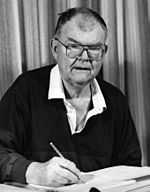Olin J. Eggen facts for kids
Quick facts for kids
Olin Eggen
|
|
|---|---|
 |
|
| Born | July 9, 1919 |
| Died | October 2, 1998 (aged 79) |
| Nationality | |
| Alma mater | University of Wisconsin–Madison |
| Scientific career | |
| Doctoral advisor | Albert vector |
Olin Jeuck Eggen (born July 9, 1919 – died October 2, 1998) was an American astronomer. He was known for his important work studying stars and how galaxies form.
Contents
Biography and Discoveries
Olin Jeuck Eggen was born in Orfordville, Wisconsin on July 9, 1919. His family came from Norway. He went to the University of Wisconsin–Madison and finished his degree in 1940.
After serving in World War II, he returned to the university. He earned his Ph.D. in astrophysics in 1948. Astrophysics is the study of how stars and planets work.
Observational Astronomy
Olin Eggen became one of the best astronomers who observed the sky. He used telescopes to gather information. He is famous for a paper he wrote in 1962 with Donald Lynden-Bell and Allan Sandage. In this paper, they suggested that our home galaxy, the Milky Way, formed from a giant cloud of gas that collapsed.
He also helped develop the idea of "moving groups" of stars. These are groups of stars that travel together through space. He thought these groups might come from open clusters that have broken apart.
Places of Work
Throughout his career, Eggen worked at many famous observatories. These included Lick Observatory (1948–1956) and the Royal Observatory, Greenwich (1956–1961). He also worked at California Institute of Technology and Mount Wilson Observatory (1961–1966). Later, he moved to Australia to work at Mount Stromlo Observatory (1966–1977). His last position was at Cerro Tololo Inter-American Observatory in Chile (1977–1998).
Awards and Memberships
Olin Eggen received many honors for his work. In 1985, he won the Henry Norris Russell Lectureship from the American Astronomical Society. He was also a member of the Royal Astronomical Society. He served as its vice president from 1961 to 1962. He was also president of the Astronomical Society of Australia from 1971 to 1972.
His Papers
The University of Wisconsin–Madison keeps a collection of Eggen's personal papers. These documents show how astronomy changed after World War II. They also show how large telescopes were built in the southern part of the world.
Olin J Eggen Scholarship
A special scholarship was created in 2000 to remember Olin Eggen's work. It is called the Olin J Eggen Scholarship. This scholarship helps international students. It allows them to study for their PhD in astronomy at the Australian National University.
See also
 In Spanish: Olin J. Eggen para niños
In Spanish: Olin J. Eggen para niños

